A single line slicing down the middle of a manmade lake, the Zaishui Art Museum is as bold as it is breathtaking. This stark, elegant form stands out against the blue-green water. Yet its scaleless simplicity harmonizes beautifully with the setting, yielding a delicate marriage of architecture and nature. While sunlight from above bathes the interior, lake water laps gently at its base, even coming inside and washing up against the concrete floor. In China, where the enormity of the open landscape so often dwarfs buildings, achieving such a balance is no small feat. Yet this was the ambitious goal of Junya Ishigami, one of Japan’s most daring designers practicing today.
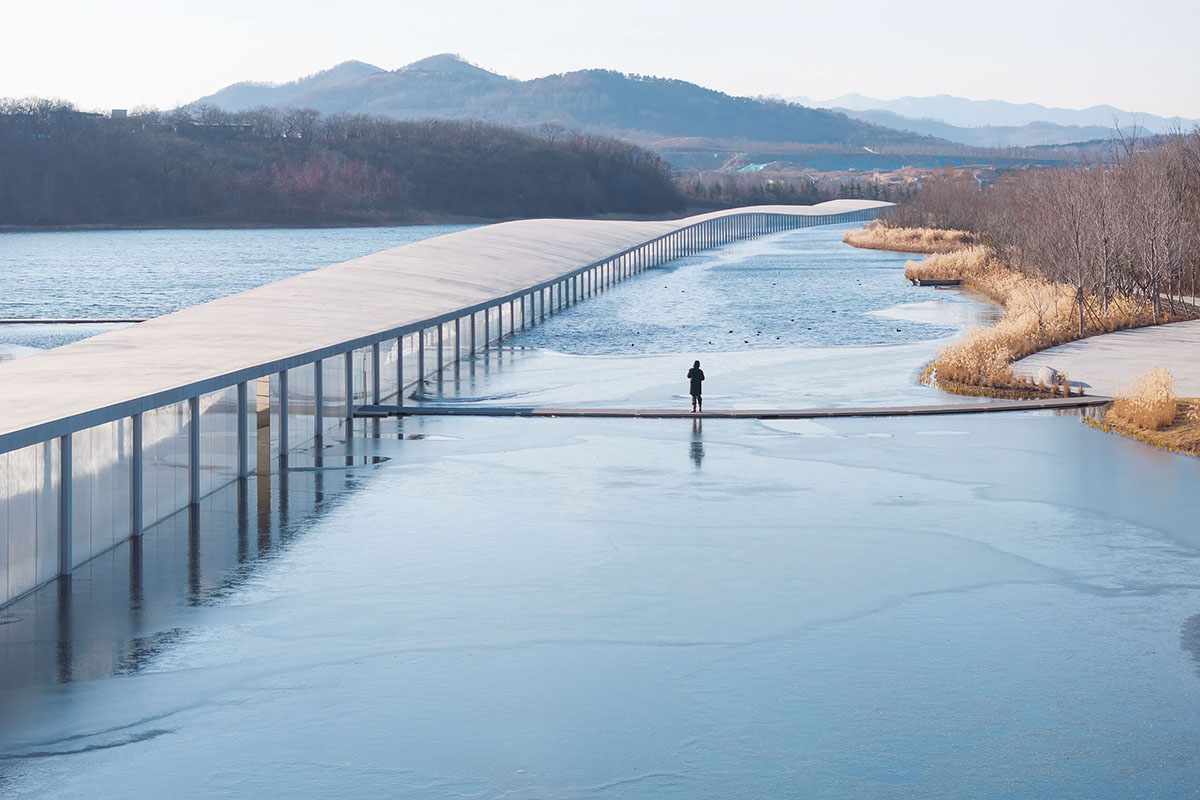
A pathway from the shoreline leads to the middle section of the building. Photo © Iwan Baan, click to enlarge.
The project began with a cold call to Ishigami from Xu Qunde, chairman of the Shandong Bailuwan Company, a developer working on a multi-stage, mixed-use project in Shandong Province. As throughout China, the land is owned by the government but was rented to the client for the purpose of development. In addition to housing and commercial buildings, several other components intended to attract tourists have been built, including the lake, and a colorful promenade and café by the Spanish firm SelgasCano. In addition, a horseback-riding center, a hotel, and a 148-foot-high, concrete church, also by Ishigami, are in process. From the outset, the developer wanted to locate the museum in relation to the lake. The question was how. In search of an answer, the client and architect together visited Wuzhen, a city laced with Venice-like canals, and considered various options proposed by Ishigami. Ultimately, their decision was not to place the 204,500-square-foot museum alongside but actually within the oblong body of water.
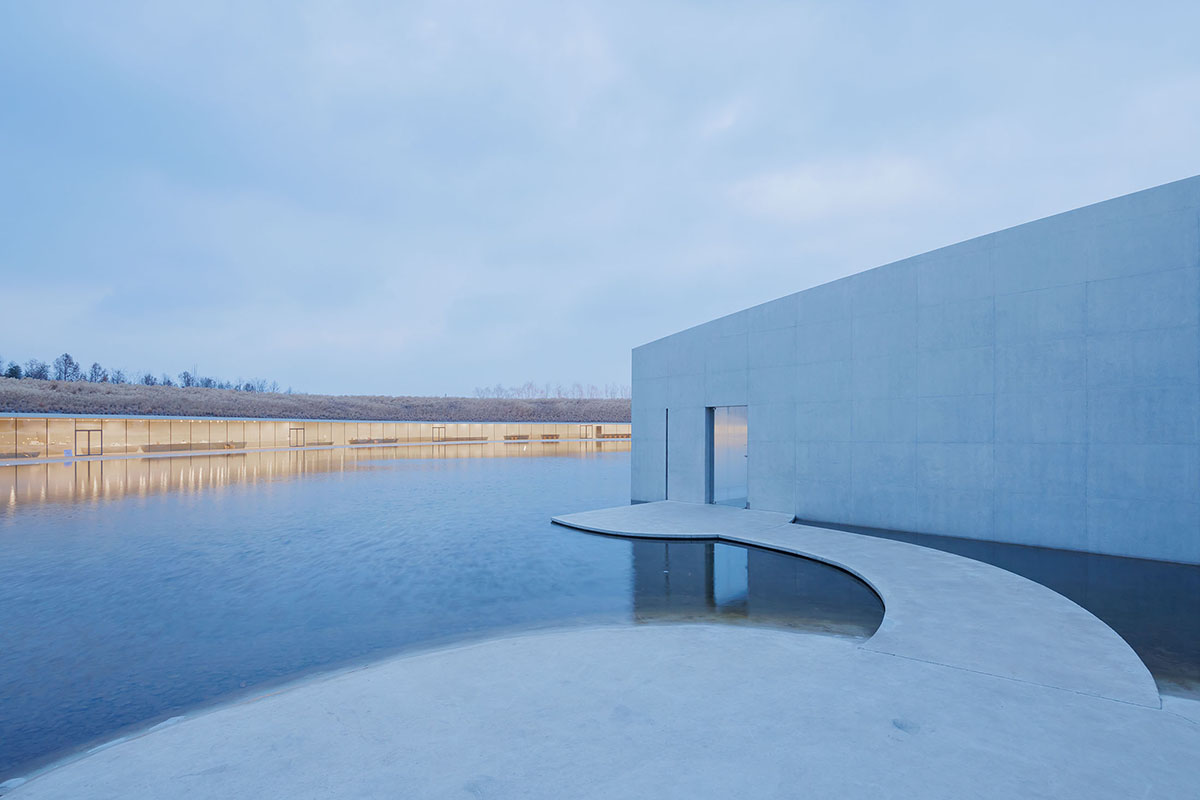
1
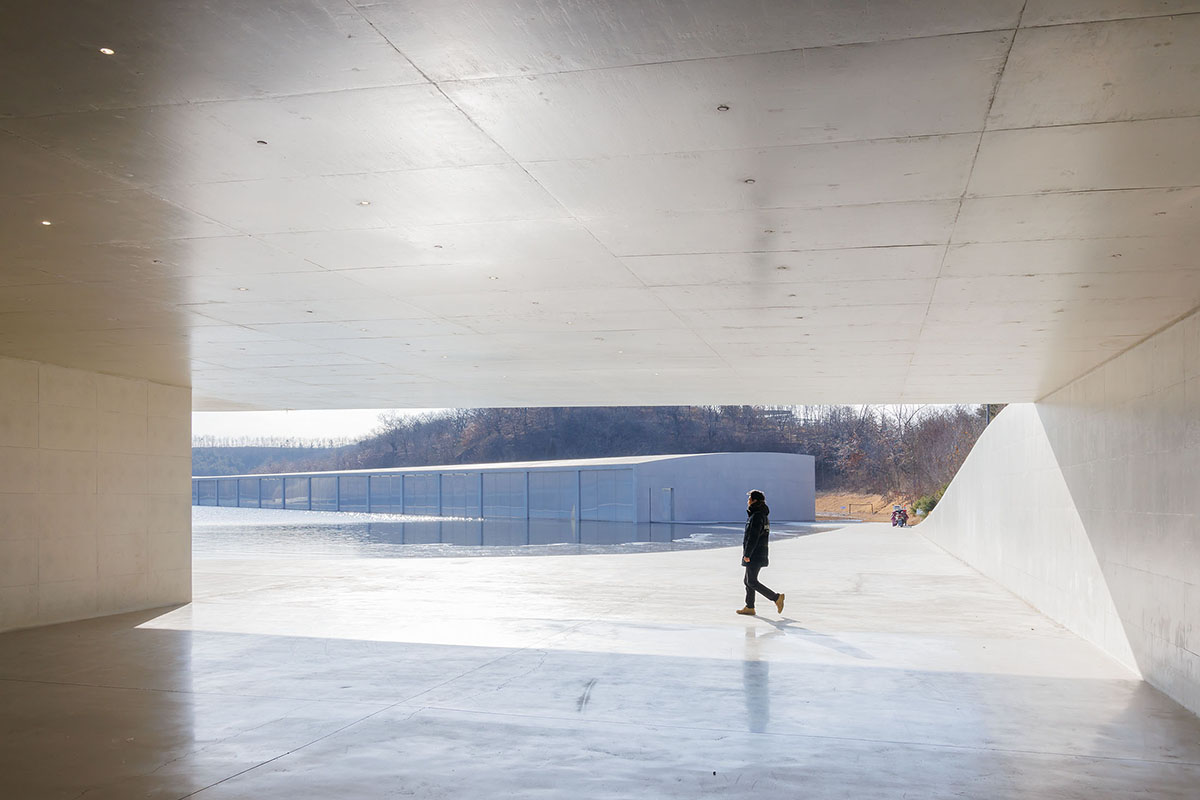
2
A doorway to the museum (1) located on the western end of the lake, opens to a path which curves toward the tunnel (2) that connects to the parking lot and town. Photos © Iwan Baan
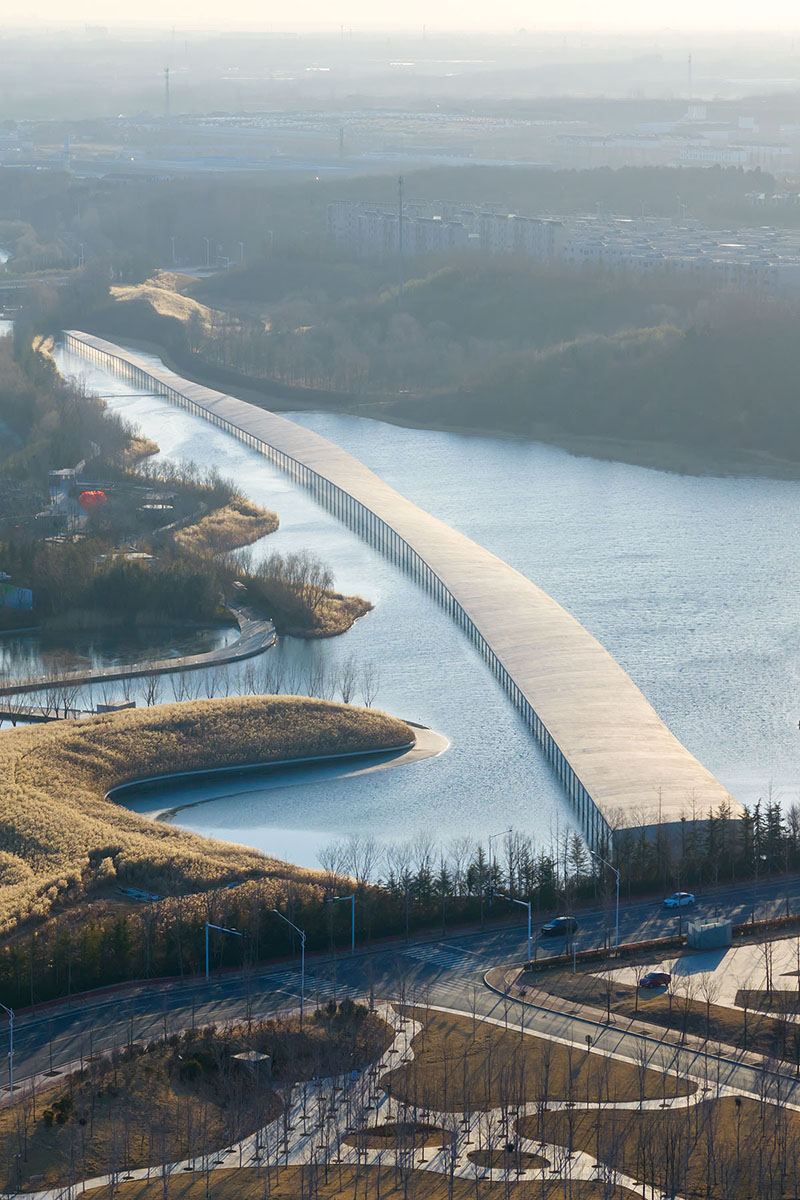
3
Aerial view of the western end of the complex, including the curvaceous secondary museum building that’s embedded into the earth and concealed by a vegetation-topped roof (3). Photo © Iwan Baan
Connected to the ground at either end, Ishigami’s building extends along the lake’s full length. The main entrance to the kilometer-long structure is at its narrow end. It opens to a corridor-like hall with side doors on either side where parking is located. Long and linear, this space leads to a fluid sequence of distinct but connected functional zones. These start with a lobby, reception area, exhibition hall and café, which are followed by additional museum display areas interspersed with informal seating. Designed for flexibility, the building can accommodate a wide variety of art installations, but its opening act features chocolate. Within this exhibition, six, clear-acrylic boxes showcase the various steps that turn cacao beans into confection, including roasting, grinding, conching and, of course, tasting.
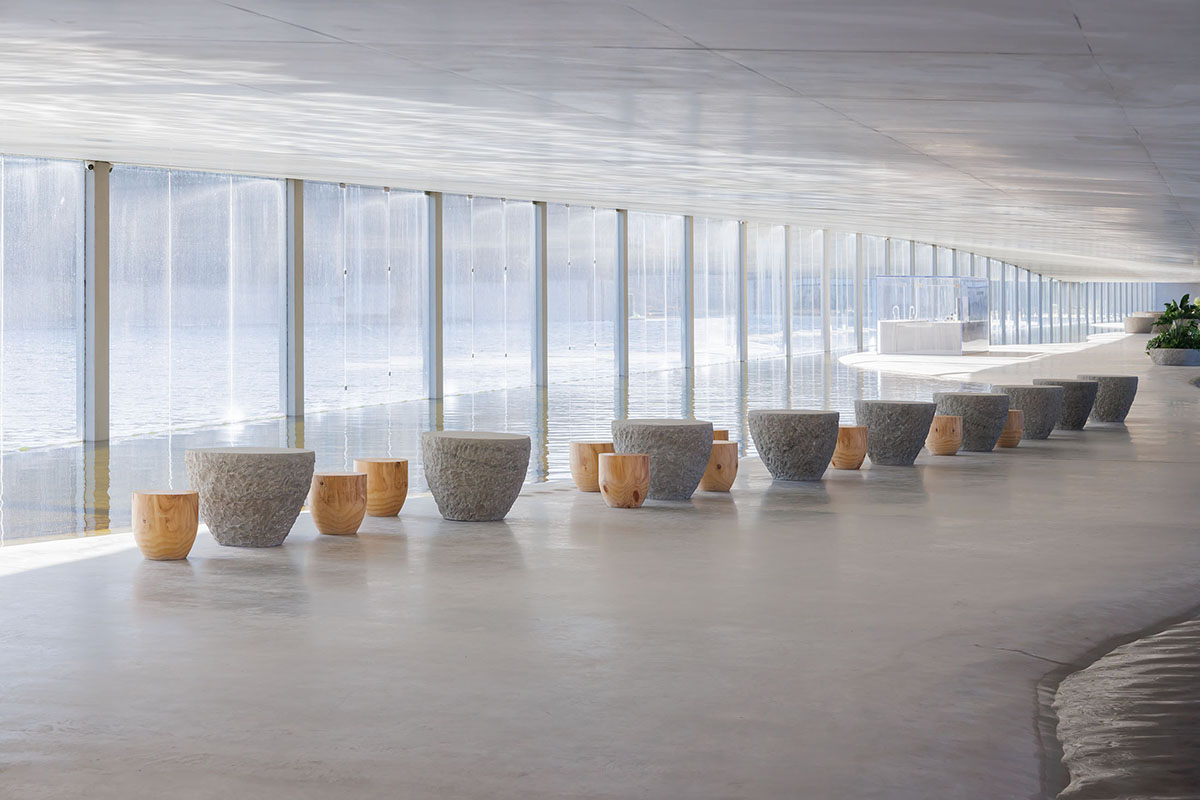
Informal seating areas, with furnishings designed by Ishigami, are dispersed throughout the space. Photo © Iwan Baan
Over the course of its length, the building volume gradually widens, from 16-feet at the east end to 66-feet at the west end where a terrace connects to a second, C-shaped structure containing a second café, a gift shop, and gallery. From here a tunnel goes under the street and leads to additional parking, as well as other parts of the greater Bailuwan development. Facing the lake, this subsidiary building is embedded in the ground and covered with a grassy roof. Its concealed form is a functional complement but physical contrast to the museum itself.
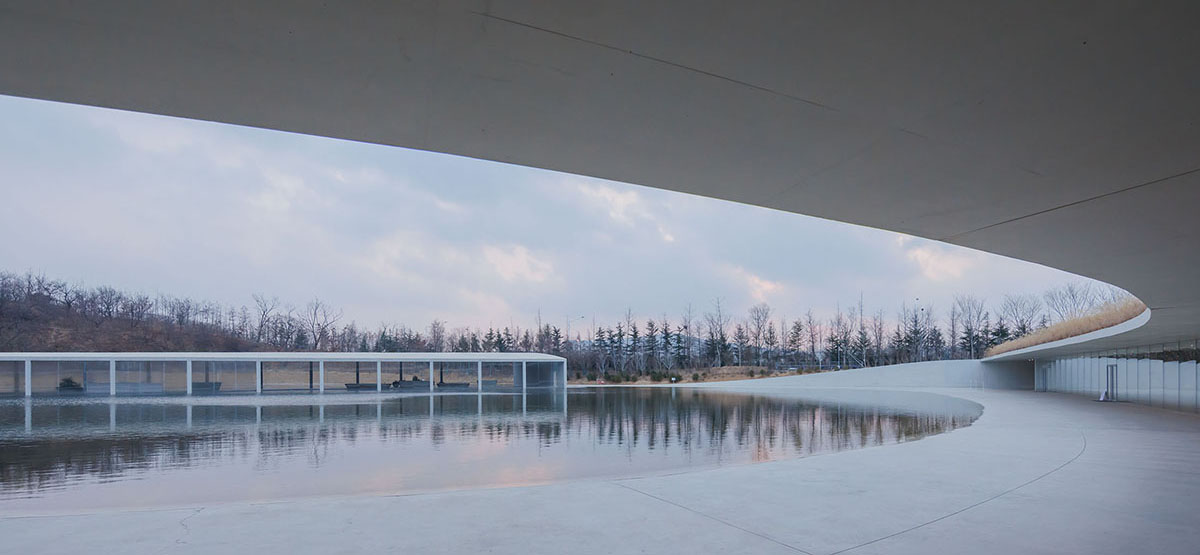
4
Topped with a green roof and featuring a wide sheltered terrace is a secondary, C-shaped structure (4 & 5) housing a gallery, gift shop, and café. Photos © Iwan Baan
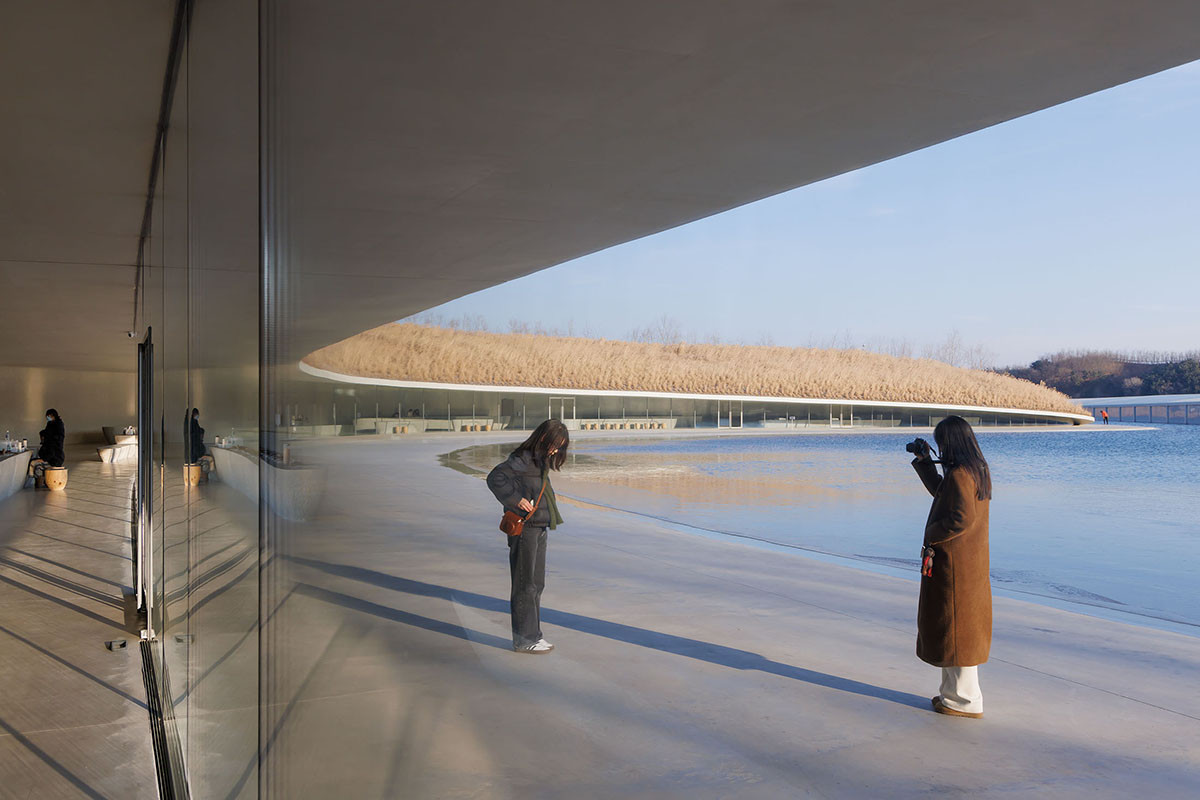
5
Within the main structure, there are no walls, partitions, or visual boundaries. Instead, a continuous, polished concrete floor distinguishes one place from the next. As in many traditional Japanese buildings, the floor is more than a surface for walking on. It is an important space-defining element, as its concrete surface expands and contracts to create programmatic areas and circulation pathways. At the narrowest point, which is in the entry hall, it cinches down to a mere seven feet wide.
Instead of a sharp divide, lake water washes up on this path’s outer edges where the concrete slopes down as gently as a sandy shoreline within the building’s glass skin. “I imagined the floor like an island,” says Ishigami. Fed from the nearby Chaobai River, the lake depth ranges from 20 inches to six feet along the transparent enclosure, which consists of 900 clear glass panes that extend 4-inches below the lake’s surface. A gap between the glazing and the concrete floor—it was designed to remain open—allows the water to flow inside but in the occupied areas the floor rises a constant 4-inches above it. In winter, when the lake freezes over, a variable-air-volume heating system under the floor keeps the interior water liquid, albeit still and glassy. In summer, soft breezes ripple its surface and gently infuse the galleries with fresh air thanks to the one hundred operable panes. “I wanted to make a new outside environment inside the building,” explains the architect.
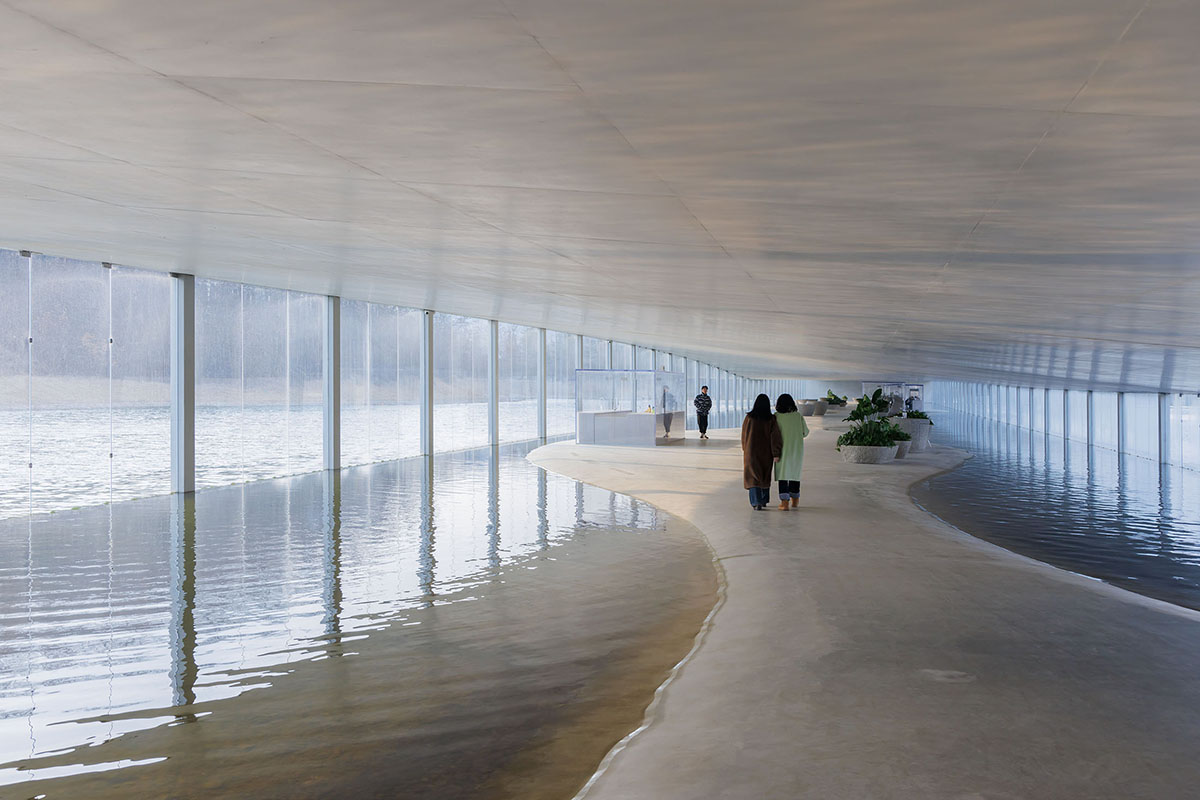
Water flows inside of the building but in the occupied areas the concrete flooring, envisioned as an island, rises above it. Photo © Iwan Baan
Interspersed with the glass, 150 steel-reinforced-concrete columns march along each side of the building. Spaced 20 feet apart and measuring 14-inches by 9-inches, they transfer their loads to single-footing foundations that rest on the lake’s stable bottom. Underwater they also support the steel bars that secure the glazing units from below. Since earthquakes are not a threat here, the rectangular members are sufficient to handle vertical as well as lateral forces. Unlike earlier Ishigami works, such as the Kanagawa Institute of Technology Workshop, a building with 305 super skinny, steel columns, the structural system was relatively straightforward. But achieving high-quality concrete construction required guidance from the architects and numerous mock-ups from the contractor.
Also made of concrete, the wavy roof undulates along its length, tilting from side to side as well as up and down. It peaks at 16 feet, its highest point, at the building’s west end, and drops to its lowest of four feet, currently near a hot cocoa sampling station in the middle of the building. These variations enabled Ishigami to manipulate the relationships between indoors and out. Where the roof tilts down sideways, only the lake can be seen, but where it tilts up the scenery expands and the hilly landscape in the distance comes into view. On its underside, the concrete ceiling is enlivened by the ever-changing sunlight whose shadows reflect off the water. Aside from portable lamps for emergencies, the sun is the museum’s only source of light, once again blurring the divide between interior and exterior. Capitalizing on the best daylight hours, the museum is only open from 10 am to 4 pm.
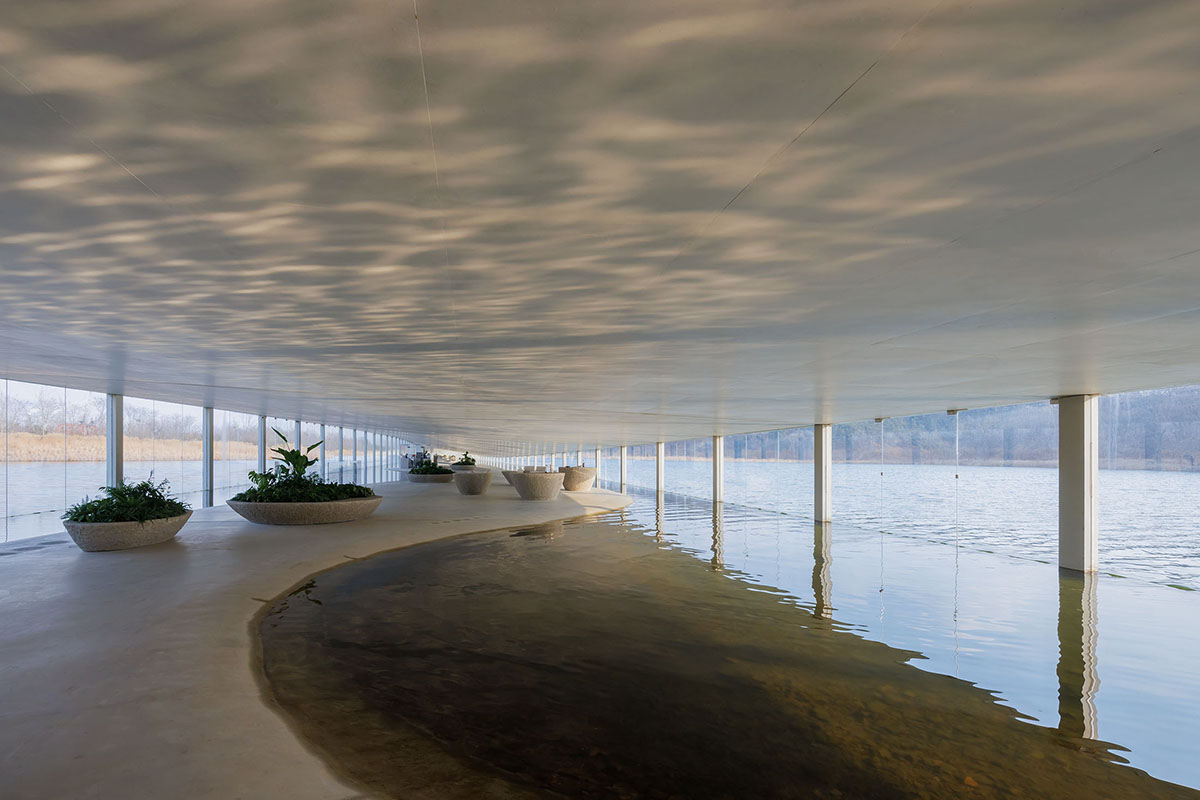
Aside from emergency lighting, the museum is illuminated by sunlight. Photo © Iwan Baan
Stepping down in scale but still underscoring the connection to the natural environment, Ishigami-designed furnishings, including planters and tables, were made primarily of local sandstone by highly skilled, Chinese craftspeople. “Since I wanted to create a new outside, the pieces look like outdoor furniture,” notes Ishigami. Throughout the building their curvaceous, sculptural forms dot the interior, inviting visitors to pause or passively pointing them on their way.
In Japan, where open buildable land is quite limited, maximum building size is tightly controlled. However, in China, where property is plentiful, the government decides the minimum floor area and clients are encouraged to build as big as possible, explains Ishigami. But, he notes, the scale of the Chinese terrain is both a strength and a weakness. “Since the environment is so vast, there are no relationships between buildings and their surroundings,” he says. Inextricably linking the two, the Zaishui Art Museum deftly raises that bar.
Click plan to enlarge
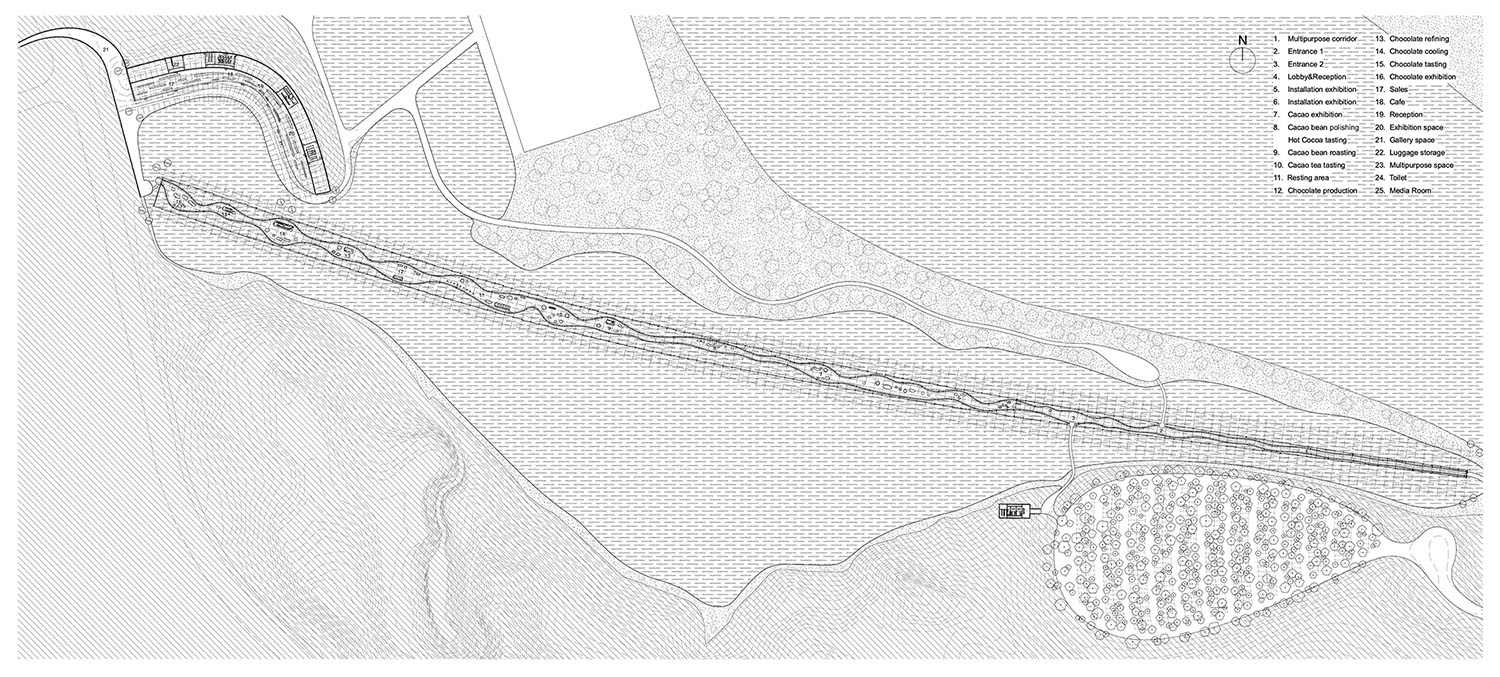
Click section to enlarge
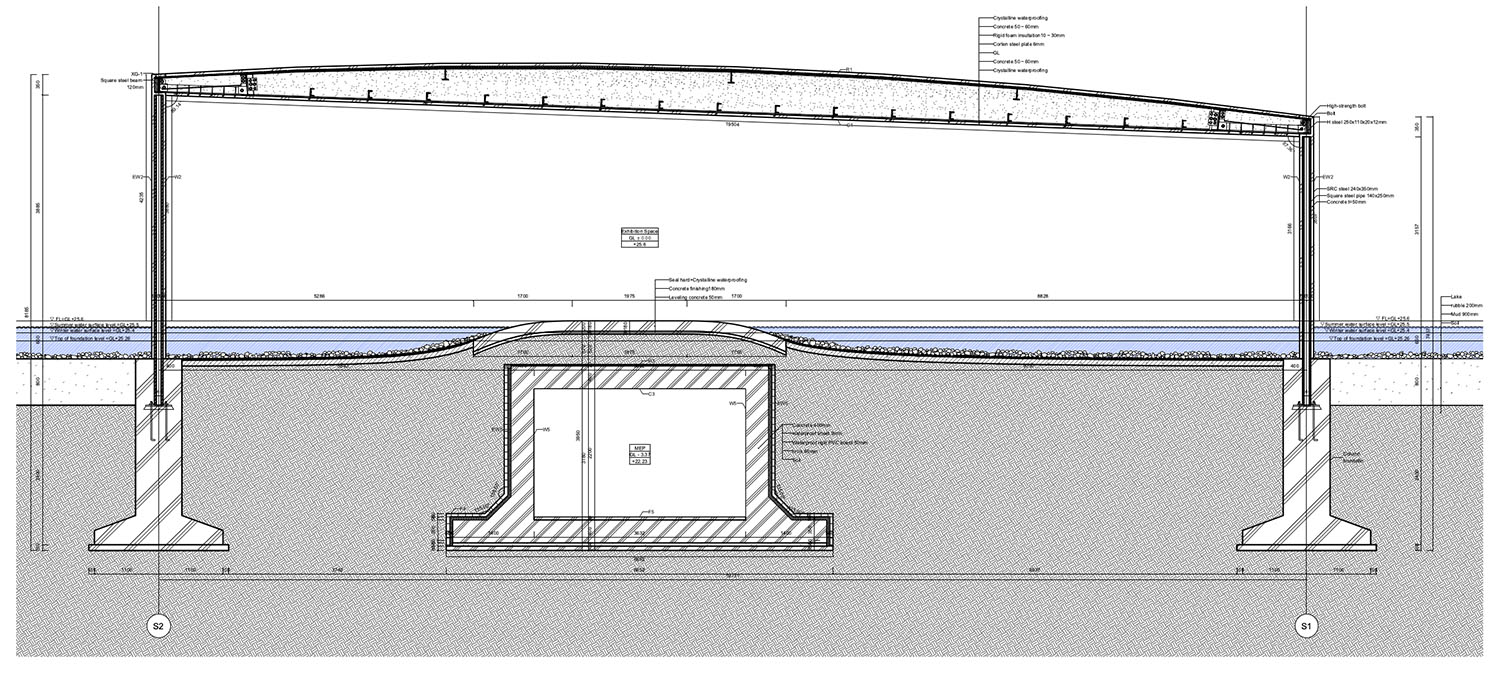
Credits
Architect:
Junya.ishigami+associates – Junya Ishigami, Zenan Li, design leads; Zhirui Lim, Sellua Di Ceglie, Rui Xu, Tong Zhang, Cing Lu, Yuxuan Zhou, Zhixuan Wei, Yunyi Zhang, Hanyang Zhou, Qinxuan Li, Jason Tan, Anping Song, Yichen Ji, project team
Engineers:
XinY structural consultants (structural); Environment-Friendly Solution to Building Services Engineering (m/e/p/lighting)
Contractor:
Beijing Yihuida Architectural Concrete Engineering Co. (reinforced concrete)
Photographer:
Iwan Baan
Location:
Rizhao, Shandong, China
Completion Date:
December 2023
Gross Square Footage:
20220m2 / 217,650 square feet
Client:
Shandong Bailuwan Co.,Ltd


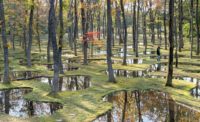
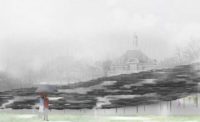
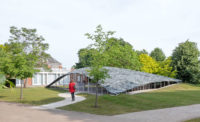
Post a comment to this article
Report Abusive Comment